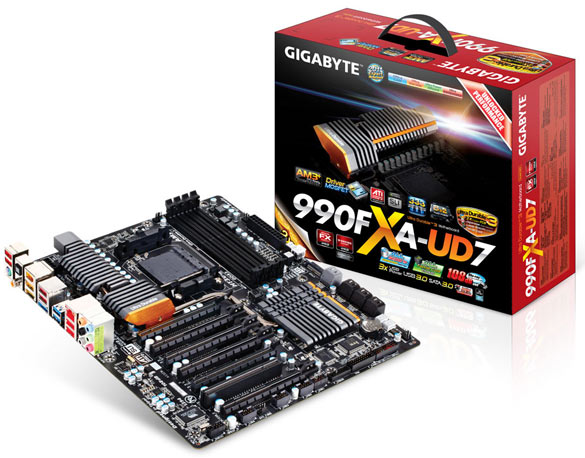AMD 990FX Mobo Round-Up: Asus, ASRock, Gigabyte
Gigabyte 990FXA-UD7
Next up we have the Gigabyte 990FXA-UD7. As you can see in the images below, this board sports Gigabyte’s newer black, grey and gold color scheme and as we’ve come to expect from high-end motherboards from the company, the 990FXA-UD7 is a very full-featured product. It’s outfitted with USB 3.0 ports and features an 8+2 phase CPU power design, Gigabyte’s “Ultra Durable 3” technology with two ounces copper layers within the PCB, 4-way CrossFireX and SLI support, DualBIOS technology, and On/Off Charge support.

|
| CPU | AM3+ Socket:
|
| Hyper Transport Bus |
|
| Chipset |
|
| Memory |
|
| Audio |
|
| LAN |
|
| Expansion Slots |
|
| Multi-Graphics Technology |
|
| Storage Interface | South Bridge:
|
| USB | South Bridge:
|
| IEEE 1394 | VIA VT6308 chip:
|
| I/O Controller |
|

Looking at the specifications and overview above, it should be evident that Gigabyte seemingly went all out on the 990FXA-UD7. While the board is feature laden and clearly targeted at enthusiasts, it does lag behind the Asus and ASRock boards in our opinion in terms of its BIOS—notice we didn’t say UEFI setup utility. More on that later.
Gigabyte 990FXA-UD7 Motherboard
The Gigabyte 990FXA-UD7 has an excellent layout and its expansion slot configuration is top-notch. All of the slots of the board except for one standard PCU slot are of the PCI Express x16 variety, and all of the board’s headers and expansion ports are clearly labeled and situated well around the edges of the board. With that said, while we do like the dark color scheme, having everything black or gray can get a little confusing. Case in point, the DIMM slots. Without color coding the DIMM slots, you’ve got to whip out the manual or carefully inspect the tiny print on the PCB to figure out which slots to use for a dual-channel configuration.
In terms of its features, the Gigabyte 990FXA-UD7 is arguably the leader of the three boards included in this article. In addition to all of the features offered by the chipset itself, the 990FXA-UD7 is outfitted with USB 3.0 support, Firewire, a POST code error reporter, two additional Marvell 88SE9172 SATA controllers, on/off USB charging support, and a Realtek ACL889 HD audio codec that’s capable of 108dB Signal-to-Noise ratio (SNR) playback quality.






